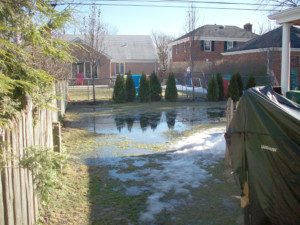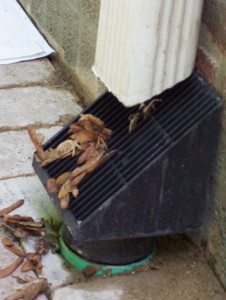Keep It Away From My House!

Standing water in a yard creates many problems inside and outside the house. Fortunately there are solutions.
When the snow melts and the ground is still frozen, or after a severe rain, our phones always seem to ring with calls about drainage problems. These range from flooded basements to ponds forming in the yard. Solutions to these problems are varied and can range from simple and relatively inexpensive to complicated and very expensive, but the most important point to remember is to keep the water away from the house. Many of the more common drainage problems can be addressed with the “passive” approach of moving water away from the foundation of the house.
Many situations we encounter involve older homes with sunken yards, new construction or additions to older homes. Sometimes the flooding is due to neighboring homes, grade changes, or settling of soil. As our communities continue to grow and more of the open land is filled in with various structures, there is less pervious surface for the water to percolate back into the ground.
Indicators of drainage problems include seepage into basements, standing water 24 hours after a hard rain, or yellowing plants. There are many different categories of drainage problems. The “nuisance” category includes water standing for extended periods of time. This may be harmful to turf, shrubs and trees and may also create a breeding ground for mosquito infestations. It also limits the functionality of your outdoor living area, limiting space for entertaining, play and pets. A more serious instance is when there is water intrusion into the home. This category is much more damaging and upsetting, limiting the use of basements, possibly causing mold and making a home more difficult to sell.

Water from this downspout flows past a debris filter, and disperses out onto a flowerbed, routed through underground drainage pipes.
Directing water away from the house is the best place to start when trying to keep water out of your basement. This is most easily accomplished with a combination of extending downspouts away from the house, keeping your gutters clean and in good working order, grading away from the home’s foundation, and routing sump pump lines away from the house. It is important to remember that, when directing rainwater away from the house, to not to direct it onto a neighboring property. This would violate city or village ordinances, and be very un-neighborly!
There are many instances when downspouts or sump pump lines end at a walkway or in an area that leaves no room for extending it. In those instances there are ways to route those lines under walkways or underground so the water can still be passively moved away. When routed underground, the lines will need to be terminated either above ground using a “Pop-up” type emitter or below ground into a gravel well or hollow vault.
Another solution is to grade settled soil away from the house. This may mean adding soil to allow it to slope away from the house. However, when adding soil you must be sure not to add too much. It is important not to raise your grade above the top of your foundation. If you do, you are enabling water to seep over the foundation wall and into the house. If you cannot raise the grade enough because of a low foundation, a false wall may need to be constructed to, in effect, raise the height of the foundation. This is a more advanced technique and must be done carefully in order for it to function properly. Again, you must be careful not to allow your rainwater to flow to onto your neighbor’s property, and you must comply with you local village or city ordinances when changing grades on your property.

A 3,000 gallon RainXchange™ System with a permeable paver patio, by Aquascape. A fountain stone filters water while adding a decorative element. A pump provides water from the underground storage chamber to aid landscape irrigation.
Alleviating flooded yards is another challenge in many neighborhoods. Whether it’s low spots in your yard, suffering from built up gravel alleys or being the lowest house on the block, standing water in your yard is a nagging problem in our area. One common way to minimize this problem is by adding soil and re-pitching the yard. Remember, you cannot push your water onto your neighbors! The re-grading and pitching would have to allow for the water to move toward the alley or street. Another way to remove standing water is to store the water below ground using underground dry vaults that store and allow water to seep into the ground or be reclaimed using a system that stores the water and allows it to be reused for watering your garden or running a water feature like a pondless waterfall or bubbling rock.
Finally, if you can’t move the water off your property, think about pitching it to a corner of the yard and creating a rain garden. Here you will need to be careful to select plants that can tolerate both wet conditions as well as dry, for those times when we have not had rains.
While not all drainage can be corrected by techniques discussed in this article, many can.
In more serious cases, one may have to actively pump the water out of the yard or have a sump pit installed by a licensed plumber.
